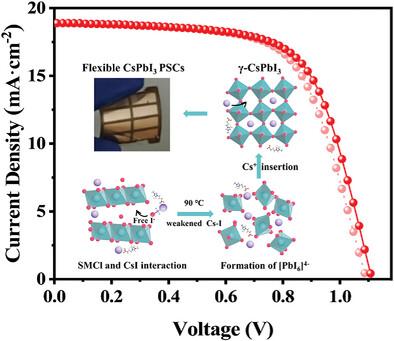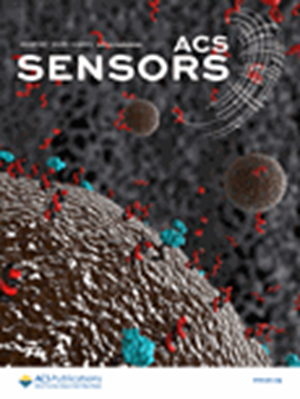通过 Cs─I 键弱化低温加工的 CsPbI3 用于柔性 Perovskite 太阳能电池
IF 8.2
1区 化学
Q1 CHEMISTRY, ANALYTICAL
引用次数: 0
摘要
全无机三碘化铯铅(CsPbI3)在过氧化物太阳能电池(PSCs)中展现出巨大的潜力。然而,高温结晶过程(≈340 或 180 °C)限制了它们的进一步发展,尤其是在柔性 PSC 中。本文提出了一种 Cs─I 键弱化方法,通过引入 1-丙基磺酸盐-3-甲基氯化咪唑(SMCl)的有机磺酸盐来实现 CsPbI3 的低温结晶。SMCl 能与 CsI 发生强烈作用,削弱 Cs─I 键,解离出游离的 I- 离子,使初始 PbI2 有效转变为 [PbI6]4-,从而将黑色 CsPbI3 的结晶温度大大降低到 90 ℃。因此,柔性 PSCs 的效率达到了 13.86%,是目前效率最高的柔性 CsPbI3 器件。此外,SMCl 还有助于释放拉伸应变并稳定 CsPbI3 相,从而获得良好的热稳定性和机械稳定性。在曲率半径为 5 毫米的情况下,柔性 PSC 经过 36000 次弯曲后几乎没有效率损失。本文章由计算机程序翻译,如有差异,请以英文原文为准。

Low-Temperature Processed CsPbI3 for Flexible Perovskite Solar Cells Through Cs─I bond Weakening
All-inorganic triiodide cesium lead (CsPbI3) exhibits huge potential in perovskite solar cells (PSCs). However, the high-temperature crystallization process (≈340 or 180 °C) limits their further development, especially in flexible PSCs. Here, a Cs─I bond weakening approach is proposed to realize the low-temperature crystallization of CsPbI3 by introducing organic sulfonate of 1-propylsulfonate-3-methylimidazolium chloride (SMCl). SMCl can strongly interact with CsI and weaken the Cs─I bond to dissociate free I− ions for the effective transition of initial PbI2 to [PbI6]4−, which greatly decreases the crystallization temperature of black CsPbI3 to 90 °C. As a result, flexible PSCs are realized with efficiency of 13.86%, which is the highest efficiency of flexible CsPbI3 devices. Besides, SMCl will also help to release the tensile strain and stabilize CsPbI3 phase, leading to good thermal and mechanical stability. Almost no efficiency loss is observed in flexible PSCs after 36000 bending cycles with a curvature radius of 5 mm.
求助全文
通过发布文献求助,成功后即可免费获取论文全文。
去求助
来源期刊

ACS Sensors
Chemical Engineering-Bioengineering
CiteScore
14.50
自引率
3.40%
发文量
372
期刊介绍:
ACS Sensors is a peer-reviewed research journal that focuses on the dissemination of new and original knowledge in the field of sensor science, particularly those that selectively sense chemical or biological species or processes. The journal covers a broad range of topics, including but not limited to biosensors, chemical sensors, gas sensors, intracellular sensors, single molecule sensors, cell chips, and microfluidic devices. It aims to publish articles that address conceptual advances in sensing technology applicable to various types of analytes or application papers that report on the use of existing sensing concepts in new ways or for new analytes.
 求助内容:
求助内容: 应助结果提醒方式:
应助结果提醒方式:


